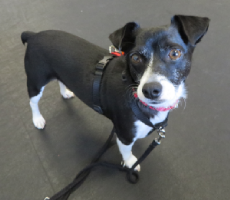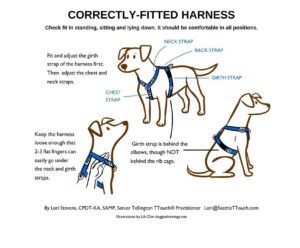Read my article called ‘Harnessing Your Dog’s Walk: How to Choose and Fit Leash-Walking Equipment’ at Karen Pryor Clicker Training.
An incorrectly fit harness can do a lot of damage both physically and behaviorally. The following tips are what to look for in a well-fitted harness.
The harness should not be tight in standing or sitting. There should be no area where the harness can rub.
The girth strap needs to be behind the elbows while the dog is standing. And it needs to be behind the elbows enough so that in sitting the girth strap is not pushing into the dog’s elbows (the back of the front legs).
The harness should not be so far back that it is behind the rib cage.
The harness should not block any movement. Pay close attention to the dog being able to do shoulder extension (front leg reaching forward) and shoulder abduction (front leg out to side) without the harness impeding movement.
The neck opening should be loose enough and forward enough on the neck such that it doesn’t fit like a collar. The lower part of the neck strap should hang closer to the prosternum (top of the sternum) rather than up around the throat.
Keep the harness loose enough that two to three flat-fingers can easily go under it but it’s not so loose as to be hanging on the dog. It should look like it fits but isn’t tight.
If you are going to connect the leash to only one ring, try the ring between the withers first, rather than the front attachment. Lori finds that people often unintentionally pull their dogs off balance when using only the front ring.
If there is a pulling issue, she recommends connecting a leash to both rings, using two points of contact, while training. Once the person and dog can walk together, without pulling, the leash can be connected to one ring. See note below.
Pay attention to the process of introducing the harness. Invite the dog to dress herself by putting her own head through the neck opening and reinforce the dog when she does.
Harness fit via girth measurements: This is meant to be a guide. Be careful of believing that a harness fits because it should according to girth measurements from the manufacturer. Use your eyes, hands, and the dog’s reaction to a harness to tell if it is a match. The dog has to be comfortable in and with the harness.
Once the neck strap is adjusted to fit over the dog’s head, then fit and adjust the girth strap. Finally adjust the chest strap and top strap (if there is one).
Note: There are excellent Tellington TTouch® techniques and leash configurations, not covered here, for a person and a dog to learn to walk in balance, i.e. without either pulling. One of the leash configurations uses two points of contact. This is where a double-ended leash is connected to the front and back of a harness at the same time. This allows the handler to provide more subtle information to the dog while both handler and dog are learning to walk in balance. 
To learn more contact Lori about the Blue-9 Pet Products Balance Harness® or purchase the DVD titled ‘Tellington TTouch® Techniques: Walking In Balance With Your Dog’.


